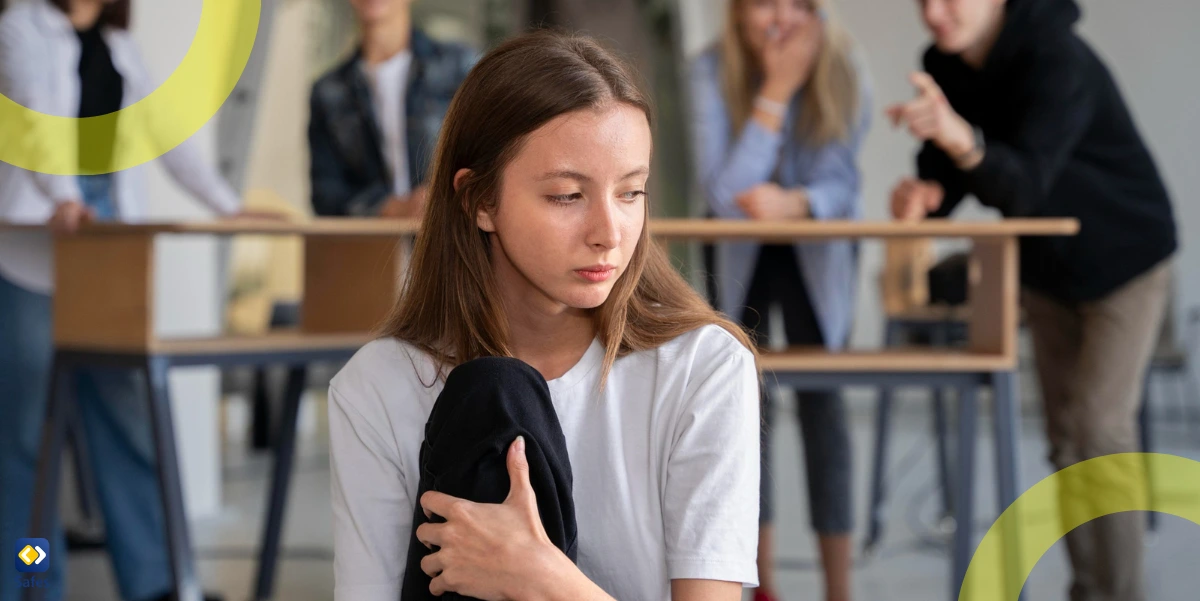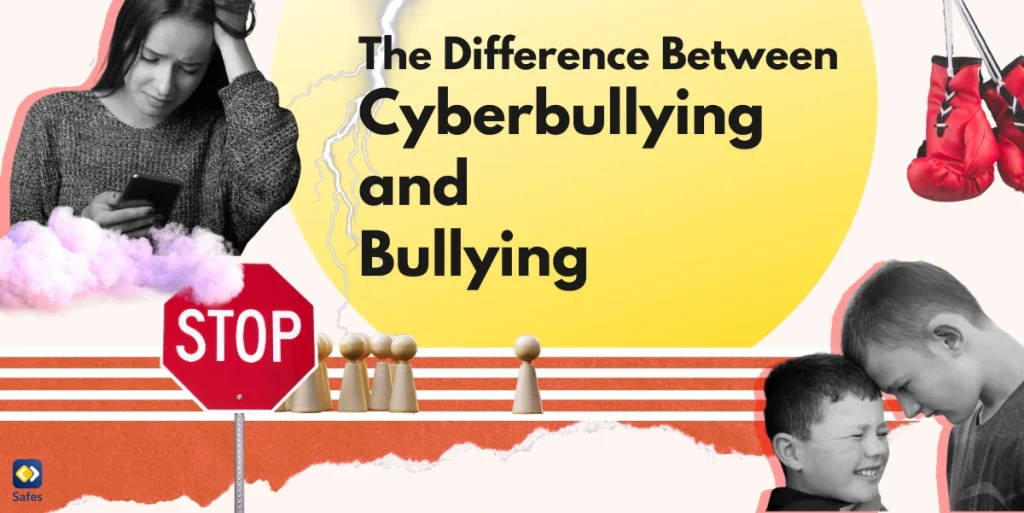Bullying is something no parent wants their child to face. But with the internet, there’s a new kind of bullying happening online, known as cyberbullying. While both bullying and cyberbullying can hurt a child’s feelings, damage their self-confidence, and even affect their mental health, there are some important differences between the two. In this blog, we’ll go over what makes cyberbullying different from traditional bullying, where and how it happens, and why it’s important to understand both. Knowing the difference between cyberbullying and bullying can help parents better support their kids and take the right steps if they ever find themselves in either situation.
Download and Start Your Free Trial of the Safes Parental Control App
What Is Bullying?
We define bullying as one person repeatedly trying to harm, control, or scare another person, usually someone they see as weaker. It’s a pattern of hurtful behavior that doesn’t happen just once but keeps going over time. For many kids, bullying can be a tough experience, affecting their emotions, self-esteem, and even their health.
What Are the Different Types of Bullying?
Bullying has different forms, each hurting kids in different ways. Here are some common types.
- Physical bullying: This is the type most people think of first. It includes hitting, pushing, kicking, or any other kind of physical harm. Physical bullying is easy to see, which often makes it easier for adults to spot.
- Verbal bullying: Verbal bullying uses words to hurt, such as name-calling, teasing, or making threats. Though it doesn’t leave physical marks, verbal bullying can be very painful and damaging, affecting how a child feels about themselves.
- Social or Relational bullying: This type is all about trying to harm someone’s reputation or friendships. It includes spreading rumors, leaving someone out on purpose, or encouraging others to ignore or exclude a person. It’s often more hidden but can be just as damaging as it makes children feel lonely or isolated.
- Damage to property: Sometimes, bullying means damaging a child’s belongings, such as their school supplies, clothes, or other personal items. This can make the victim feel unsafe and scared about what might happen next.
Where Does Bullying Happen?
Bullying can take place almost anywhere children interact, such as at school, on the playground, during after-school activities, or even on the bus. It tends to happen in places where there might not be adult supervision, giving the bully a chance to act without being seen.
How Does Bullying Affect Kids?
The impact of bullying on children can be serious and long-lasting. Kids who are bullied often feel:
- Anxious,
- Sad,
- Or alone.
This can affect their mood, school performance, and willingness to participate in activities. They might not want to go to school or spend time with friends, fearing they’ll run into their bully. Over time, bullying can even lead to more serious issues like depression or low self-worth. Moreover, according to an article, kids who have been bullied are more likely to show self-harm behaviors.

What Is Cyberbullying?
Cyberbullying is bullying that takes place online or through digital devices. Unlike traditional bullying, which usually happens in person, cyberbullying occurs on social media, text messages, emails, and even online games. It allows bullies to reach their targets anywhere, at any time. Because of this, cyberbullying can feel overwhelming and constant for children and teens.
What Are Some Cyberbullying Examples?
To better explain cyber bullying, it pays off to check some examples that parents should be aware of.
- A child posts a photo on Instagram, and another child repeatedly leaves hurtful comments, like calling them ugly or making fun of their appearance.
- Someone starts a rumor about a student in a group chat or on social media, saying they did something embarrassing or unkind.
- In group messaging apps, classmates might deliberately exclude someone from chats or group activities or even create separate groups to talk badly about that person.
- A bully might share a photo or video of someone in an embarrassing situation without their permission, like a clip of them tripping or a picture taken without their knowledge.
- Someone might create a fake profile pretending to be another child, posting mean or inappropriate messages to make that child look bad.
What Are the Consequences of Cyberbullying?
Cyberbullying can be extremely upsetting and damaging for kids. Because it often happens away from the watchful eyes of adults, children may feel isolated and alone in dealing with it. There are even more negative impacts that parents should know.
- Increased anxiety and sadness: Cyberbullying can make kids feel anxious, sad, or withdrawn, often more intensely than face-to-face bullying.
- Lowered self-esteem: Constant negative messages can lead children to doubt themselves and feel insecure.
- Sleep and eating issues: It may even affect kids’ physical health, causing trouble with sleep, changes in eating habits, and physical symptoms like stomach aches or headaches.
- Impact on schoolwork: Kids affected by cyberbullying might have trouble focusing on school, leading to lower grades and less interest in activities they used to enjoy.
Bullying vs Cyberbullying: Which One Is More Harmful?
Both bullying and cyberbullying can hurt children deeply, but each has unique ways of affecting them. It’s hard to say which one is “more harmful” because the impact depends on the child and the situation. However, here are some reasons why each type can be damaging in different ways.
Why Traditional Bullying Can Be Very Harmful
Traditional bullying often happens face-to-face. Children who are physically or verbally bullied at school may feel scared to go to certain places, like the playground or lunchroom, and this can make them feel anxious during the school day. Physical bullying can cause visible injuries, while verbal bullying can leave lasting emotional scars. In person, a child might feel trapped and unable to escape from their bully, especially if they see them every day.
Why Cyberbullying Can Be Very Harmful
Cyberbullying happens online, which means it can follow kids anywhere, even when they’re at home. This makes it feel constant like there’s no safe place to escape. Additionally, cyberbullying can spread fast because messages, photos, or rumors can reach many people at once. When something is shared online, it’s harder to control or remove, so kids may worry about their reputation for a long time. And because it’s online, it can sometimes be hidden from parents and teachers, making it harder for kids to ask for help.
So, Which One Is Worse?
There’s no simple answer. Some children find face-to-face bullying harder to handle because it feels direct and scary in the moment. Others feel more affected by cyberbullying because it can spread quickly and seem like it will never go away.
In both cases, the effects can be serious, leading to feelings of sadness, anxiety, and low self-esteem. The most important thing is for parents to be aware of both types and to create a safe space for their children to talk about any bullying they might face. Each child is different, so the best approach is to listen and offer support based on what they’re going through.

How to Protect Our Children from Cyberbullying and Bullying?
As parents, it’s natural to worry about our children’s safety and well-being, especially when it comes to bullying and cyberbullying. While we can’t always control what happens to them, there are some powerful steps we can take to help protect them and make them feel safe.
1. Have Open Discussions with Them
Make sure your child knows they can talk to you about anything. Regularly ask them about their day, friendships, and experiences at school or online. If your child feels comfortable opening up to you, they’re more likely to tell you if they’re facing any form of bullying. Let them know that you won’t judge or blame them and that you’ll support them in handling the situation.
2. Teach Them About Bullying and Cyberbullying
Talk with your child about the definition of cyberbully and bullying. Explain to them that bullying can happen face-to-face and online and that neither type is okay. Give them examples so they can recognize it if it happens to them or others.
3. Set Guidelines for Safe Internet Use
Set rules for using the internet and social media. Explain that sharing too much personal information can sometimes lead to negative experiences. Encourage them to keep accounts private, avoid adding strangers as friends, and think carefully before sharing posts or pictures. These steps can protect them from unwanted attention and cyberbullying.
4. Monitor Their Online Activities Gently
While children need privacy, it’s also important for parents to stay aware of their online activities. You can set up parental controls, but it’s just as helpful to check in about what they’re doing online. You can also show interest in the apps and sites they’re using without making them feel like you’re invading their space. A gentle approach can help them feel comfortable sharing any issues they may face.
Final Word
Throughout the blog, we discussed bullying and cyberbullying meaning to understand how they differ from each other. With both online and offline bullying becoming part of children’s lives today, it’s essential to equip ourselves and our kids with the right tools to prevent and manage these challenges.
You can use Safes as your family’s safety toolkit. Safes is a parental control app designed to help parents monitor and guide their children’s online activity in a supportive, balanced way. With features similar to parental controls on Android that allow you to set safe online boundaries, control screen time, and receive alerts if risky content or activity arises, Safes makes it easier to stay involved and protect your child without intruding.
To see how Safes can support your family, download the app on Android or iOS and try out our free trial today.
Your Child’s Online Safety Starts Here
Every parent today needs a solution to manage screen time and keep their child safe online.
Without the right tools, digital risks and excessive screen time can impact children's well-being. Safes helps parents set healthy boundaries, monitor activity, and protect kids from online dangers—all with an easy-to-use app.
Take control of your child’s digital world. Learn more about Safes or download the app to start your free trial today!




